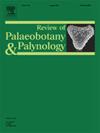Rising Himalaya and climate change drive endemism in the Western Ghats: Fossil evidence insights
IF 1.7
3区 地球科学
Q2 PALEONTOLOGY
引用次数: 0
Abstract
Endemism, driven by geological and climatic transformations, is a hallmark of biodiversity hotspots. Fossil evidence offers unique insights into the historical biogeography and evolutionary trajectories of endemic taxa, particularly in biodiversity-rich regions like northeast India and the Western Ghats. This study reports the discovery of two Nothopegia species (Anacardiaceae) from late Oligocene sediments in the Makum Coalfield, Assam, northeast India. These fossils represent the earliest global record of the genus and display striking morphological similarities to the extant Nothopegia travancorica and N. castaneifolia, currently restricted to the Western Ghats, indicating a significant biogeographic shift over millions of years. Paleoclimatic and paleolatitudinal reconstructions suggest that the late Oligocene climate of northeast India mirrored the present-day equable climate of the Western Ghats, enabling the survival of Nothopegia in the region. However, the uplift of the Himalayan-Tibetan Plateau and a pronounced decline in the cold month mean temperature (CMMT) across northern and northeastern India likely drove the extinction of Nothopegia from these areas, confining it to the warmer environments of the Western Ghats. Present fossil evidence, along with previous fossil records of other plant taxa, underscores deep-time floristic connectivity between northeast India and the Western Ghats, likely facilitated by evergreen Paleogene forest corridors. These findings illuminate the biogeographic history of megadiverse ecosystems of South Asia and highlight the interplay between climatic shifts and geological events in shaping endemic biodiversity. Furthermore, the study demonstrates the critical role of paleobotanical data in guiding modern conservation strategies, particularly for relict taxa confined to isolated biodiversity hotspots.

喜马拉雅山脉的上升和气候变化推动了西高止山脉的地方性:化石证据的见解
由地质和气候变化驱动的地方性是生物多样性热点的一个标志。化石证据为了解地方性分类群的历史生物地理学和进化轨迹提供了独特的见解,特别是在生物多样性丰富的地区,如印度东北部和西高止山脉。本文报道了在印度东北部阿萨姆邦Makum煤田晚渐新世沉积物中发现的两种Nothopegia (Anacardiaceae)。这些化石代表了该属最早的全球记录,并显示出与现存的nothoopegia travancorica和N. castaneifolia惊人的形态相似性,目前仅限于西高止山脉,表明了数百万年来重大的生物地理转变。古气候和古纬度重建表明,印度东北部晚渐新世的气候反映了现今西高止山脉的稳定气候,使nothoopegia在该地区得以生存。然而,喜马拉雅-青藏高原的隆起和印度北部和东北部寒冷月平均温度(CMMT)的显著下降可能导致了这些地区nothoopegia的灭绝,将其限制在西高止山脉的温暖环境中。目前的化石证据,以及之前其他植物分类群的化石记录,强调了印度东北部和西高止山脉之间的深层植物区系联系,可能是由常绿的古近纪森林走廊促进的。这些发现阐明了南亚超级多样化生态系统的生物地理历史,并强调了气候变化和地质事件在形成地方性生物多样性方面的相互作用。此外,该研究还证明了古植物学数据在指导现代保护策略方面的关键作用,特别是对于局限于孤立的生物多样性热点地区的遗存分类群。
本文章由计算机程序翻译,如有差异,请以英文原文为准。
求助全文
约1分钟内获得全文
求助全文
来源期刊
CiteScore
3.50
自引率
21.10%
发文量
149
审稿时长
6 months
期刊介绍:
The Review of Palaeobotany and Palynology is an international journal for articles in all fields of palaeobotany and palynology dealing with all groups, ranging from marine palynomorphs to higher land plants. Original contributions and comprehensive review papers should appeal to an international audience. Typical topics include but are not restricted to systematics, evolution, palaeobiology, palaeoecology, biostratigraphy, biochronology, palaeoclimatology, paleogeography, taphonomy, palaeoenvironmental reconstructions, vegetation history, and practical applications of palaeobotany and palynology, e.g. in coal and petroleum geology and archaeology. The journal especially encourages the publication of articles in which palaeobotany and palynology are applied for solving fundamental geological and biological problems as well as innovative and interdisciplinary approaches.

 求助内容:
求助内容: 应助结果提醒方式:
应助结果提醒方式:


